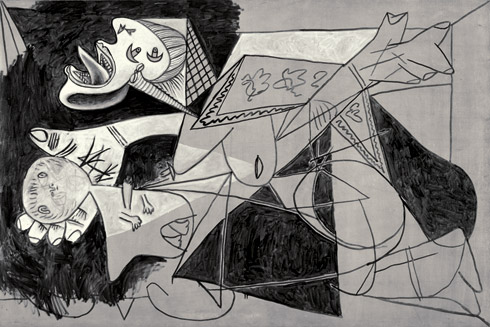Fear
Fear
is unknown; I’ve felt it in my fingers and toes. I backpack it in my
nightmares. The devil’s face in sickening colours engulfs my shadow.
Lilacs hum a weedy tune. The livid
oracle smears my porous skin. Running past tunnels of thick darkness, a magenta
scream escapes my mouth. I relive the murky past. The surging clouds are
snowflakes of agony. It drizzles. I can steer crystal clear. A pain is logged
on my mother’s face, as she holds a dead foetus in skinny hands.Trees mourn-a
deadening grief- an embryo of grief. The language of a rusty noon with shackles
of sand is gritty. My mother rocks herself to sleep. Her muffled grief courts
the dance of death. She repels my doomed thoughts. I squirm in it. The dread is
a sepulcher of our fragrant dreams long lost in her hazel eyes.
 Femme avec enfant mort II, Post-scriptum à Guernica (Mother with Dead Child II, Postscript to Guernica)-- Pablo Picasso
Femme avec enfant mort II, Post-scriptum à Guernica (Mother with Dead Child II, Postscript to Guernica)-- Pablo Picasso

Guernica [detail] -- Pablo Picasso
 Femme avec enfant mort II, Post-scriptum à Guernica (Mother with Dead Child II, Postscript to Guernica)-- Pablo Picasso
Femme avec enfant mort II, Post-scriptum à Guernica (Mother with Dead Child II, Postscript to Guernica)-- Pablo Picasso
Guernica [detail] -- Pablo Picasso
On behalf of their ally Francisco Franco the German Legion Condor and the Italian Aviazione Legionaria bombed the Basque village of Guernica on 26 April 1937. Pablo Picasso saw the first photos documenting its destruction in the Parti communiste français (French Communist Party) newspaper “L'Humanité” on 29 April. In January the Spanish government had commissioned him to create a mural for the World’s fair in Paris, and the poet Juan Larrea encouraged him to make the bombing his subject. After reading George Steer’s eyewitness accounts Picasso began painting “Guernica” in gray, black, and white, which he completed on 4 June after 35 days of work on it. At the end of 1935, Dora Maar (Henriette Theodora Markovitch), a surrealist photographer, painter, and poet, was a set photographer on a Jean Renoir film, and Paul Eluard introduced her to Pablo Picasso. They became lovers, and their liaison lasted 9 years. (She was the model for his “Monument à Apollinaire.”) She taught him the technique of cameraless photography and documented the stages of the creation of “Guernica.” She is credited with persuading him not to use color, and Picasso had a matte house paint specially formulated to have the least possible gloss. After completing “Guernica” Picasso created a series of works depicting weeping women and representations of maternity inspired by her striking features, including “Mother with Dead Child II, Postscript to Guernica.”
ReplyDelete